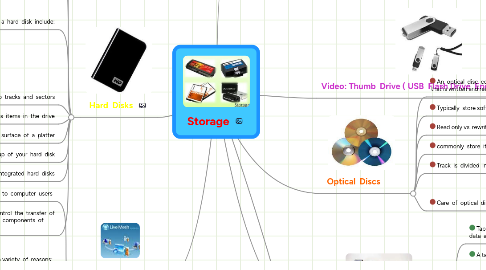
1. Hard Disks
1.1. contains one more inflexible
1.1.1. circular platters that use magnetic particles to store data
1.1.2. instructions
1.1.3. New ninformationode
1.2. can store data using longitudinal recording or perpendicular recording
1.3. Characteristics of a hard disk include:
1.3.1. Capacity
1.3.2. Platters
1.3.3. Read/write Heads
1.3.4. cylinders
1.3.5. Sectors and Tracks
1.3.6. Revolution per Minute
1.3.7. Access Time
1.4. Formatting is the process of dividing the disk into tracks and sectors
1.5. arms move the read/write head, which reads items and writes items in the drive
1.5.1. Location often is referred to by its cylinder
1.6. A head crash occurs when a read/write head touches the surface of a platter
1.7. Always keep a backup of your hard disk
1.8. RAID is a group of two or more integrated hard disks
1.9. A disk controllers consists of a special-purpose chip and electronic circuits that control the transfer of data, instructions, and information from a disks to and from the system bus and other components of the computer
1.9.1. SATA
1.9.2. EIDE
1.9.3. SCSI
1.9.4. SAS
2. Flash Memory Storage
2.1. Flash memory chips are a type of solid state media and contain no moving parts
2.2. Solid state drives ( SSDs) have several advantages over magnetic hard disks:
2.3. A memory card is a removable flash memory device that you insert and remove from a slot in a computer, mobile device, or card reader/writer
2.3.1. Secure Digital (SD)
2.3.2. Secure Digital High Capacity SDHC
2.3.3. micro SD
2.3.4. microSDHC
2.3.5. xD Picture Card
2.3.6. Memory Stick
2.3.7. Memory Stick Micro (M2)
2.4. USB flash drives plug into a USB port on a computer or mobile device
2.5. An Express Card module is a removable device that fits in an Express Card slot
2.6. Developed by the PCMCIA
2.7. Commonly used in notebook computers
3. Cloud Storage
3.1. is an internet service that provides storage to computer users
3.2. Users subscribe to cloud storage for a variety of reasons:
3.2.1. Access files from any computer
3.2.2. Store large files instantaneously
3.2.3. Allow others to access their files
3.2.4. View time-critical data and images immediately
3.2.5. Store offsite backups
3.2.6. Provide data center function
4. Storage
4.1. Capacity is the number of bytes a storage medium can hold
4.2. device is the computer hardware that record and/or retrieves items to and from storage media
4.3. Access time measures
4.3.1. The amount of time it takes a storage device to locate an item on a storage medium
4.3.2. The time required to deliver an item from memory to the processor
5. Video: Thumb Drive ( USB Flash Drive Encryption)
6. Optical Discs
6.1. An optical disc consists of a flat, round, portable disc made of matal, plastic, and lacquer that is written and read by a laser
6.2. Typically store software, data, digital photos, movies, and music
6.3. Read only vs. rewritable
6.4. commonly store items in a single track that spirals from the center of the disc to the edge
6.5. Track is divided into evenly sized sectors
6.6. Care of optical discs
6.6.1. A CD –ROM
6.6.2. A CD-R
6.6.3. A CD-RW
7. Other Types of Storage
7.1. Tape is a magnetically coated ribbon of plastic of storing large amounts of data and information
7.2. A tape drive reads and writes data and information on a tape
7.3. A magnetic stripe card contains a magnetic stripe that stores information
7.4. A smart card stores data on a thin microprocessor embedded in the card
7.5. Microfilm and microfiche store microscopic images of documents on a roll or sheet film
7.6. Enterprise storage stores huge volumes of data and information for large businesses
7.6.1. Uses special hardware for heavy use, maximum availability, and maximum efficiency
